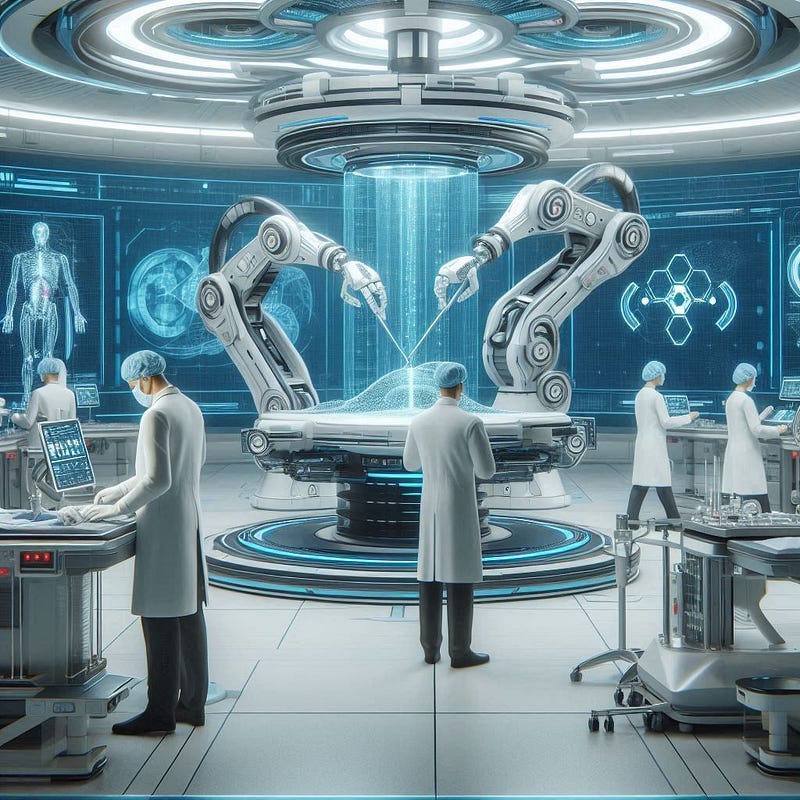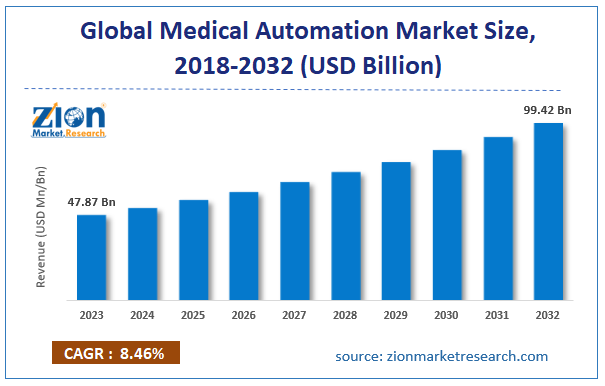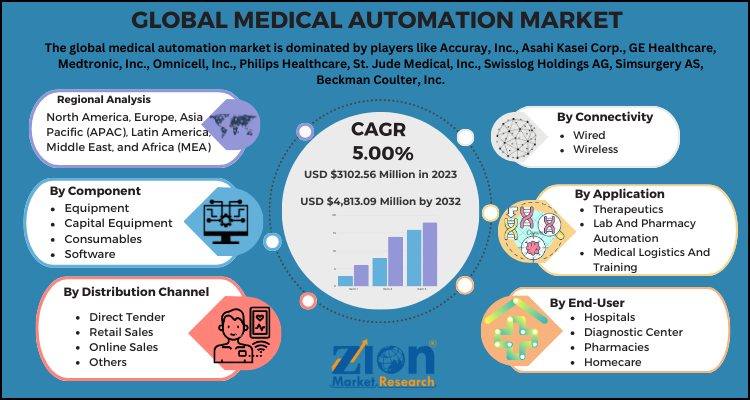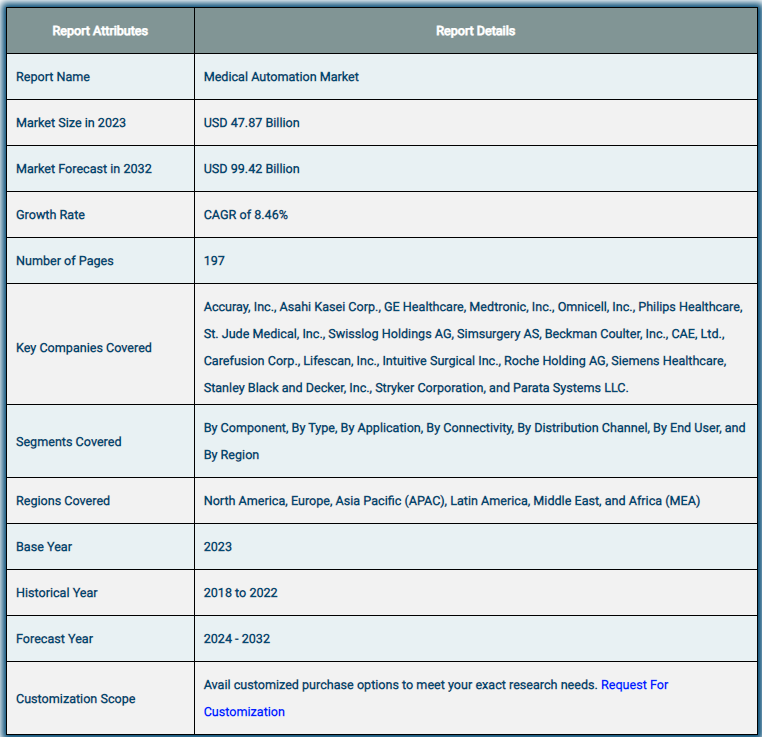Medical Automation Market Trend, Share, Growth, Size and Forecast 2032

✈👉Get a Free Sample: 🚀https://www.zionmarketresearch.com/sample/medical-automation-market
Introduction:
- Overview of Medical Automation:
Define medical automation as the use of technology to perform tasks in healthcare that were traditionally done by humans. This includes automation in laboratories, surgical procedures, medication management, and patient monitoring. - Importance of the Market:
Discuss the significance of medical automation in enhancing efficiency, reducing human error, improving patient care, and lowering operational costs in healthcare settings.

Overview of the Global Medical Automation Market
Automation is the independent use of control systems and software to monitor a mechanised system for a variety of industrial activities. Better results are achieved by streamlining procedures, cutting costs, and eliminating errors using automated medical practices. The market is expanding as a result of rising labour costs, rising government spending, and rising patient demand for precise and dependable medical operations.
Growth Factors for the Global Medical Automation Market
The demand for accuracy and dependability in medical procedures is rising, which is driving up the cost of labour. Other factors contributing to this growth include technological advancements, government investments, the growing prevalence of chronic conditions worldwide, and the expanding use of point-of-care testing kits, such as HIV and pregnancy test kits. Automating pharmacies and labs can provide a number of advantages, including reduced errors, cost savings, dependability, and speed. The market for medical automation will benefit from this. Cost concerns and globally enforced stringent government regulations for medical device makers are some of the market’s restraints, though.

✈👉Directly Purchase a copy of the report with TOC: 🚀https://www.zionmarketresearch.com/toc/medical-automation-market
Market for Medical Automation: Report Extent

Segmentation of the Global Medical Automation Market
The medical automation market is divided into geographies, applications, and end uses on a global scale. The global automation market is divided into four segments based on application: medical logistics and training, lab and pharmacy automation, therapeutic automation, and diagnostic and monitoring automation. The market is divided into four segments based on the end user: hospitals & diagnostic centres, pharmacies, home & ambulatory care, and research laboratories & institutes.
Global Market for Medical Automation: Regional Evaluation
The medical automation market is divided into several regions, including North America, Europe, Asia-Pacific, and the Rest of the World. North America is the region with the most market share in the medical automation industry. Asia-Pacific and Europe come after North America. The government’s increased funding and investment initiatives are the main factors driving market expansion. The US holds the biggest market share in the North American medical automation industry. This is because, in the US market, the therapy segment has the largest revenue share, followed by monitoring, diagnostics, training, and logistics.
Future market growth in the Asia Pacific area is expected to be robust due to advancements made in growing nations like China, Japan, Taiwan, and India. The decrease in the labour force and the increase in government investments are the elements contributing to this expansion.
Market Drivers:
- Increasing Demand for Healthcare Efficiency:
The growing need for operational efficiency in healthcare facilities is driving the adoption of automation solutions to streamline processes and improve productivity. - Technological Advancements:
Rapid advancements in technology, including robotics, artificial intelligence (AI), and machine learning, are facilitating the development of more sophisticated medical automation solutions. - Rising Prevalence of Chronic Diseases:
An increase in chronic diseases necessitates more efficient healthcare delivery systems, which can be achieved through automation. - Aging Population:
The growing elderly population, which requires continuous and complex care, is driving the demand for automated solutions that can enhance patient management.
Market Restraints:
- High Initial Investment Costs:
The significant capital investment required for implementing automation technologies can be a barrier for smaller healthcare facilities. - Regulatory Challenges:
The medical automation market is subject to strict regulations, and navigating these can slow down the introduction of new technologies. - Resistance to Change:
There may be resistance from healthcare professionals who are accustomed to traditional practices, which can hinder the adoption of automation technologies.
Market Segmentation:
- By Type of Automation:
- Laboratory Automation: Includes automated analyzers and robotic systems used in diagnostic laboratories.
- Surgical Automation: Encompasses robotic surgical systems and automated surgical instruments.
- Medication Management Automation: Involves automated dispensing systems and electronic medication administration records.
- Patient Monitoring Automation: Includes remote monitoring systems and wearable devices for real-time health tracking.
- By Application:
- Hospitals: The largest application segment utilizing automation for various processes, including patient management and diagnostics.
- Diagnostic Laboratories: Facilities implementing automation to enhance testing accuracy and throughput.
- Pharmacies: Utilizing automation for medication dispensing and inventory management.
- By End-User:
- Healthcare Providers: Hospitals, clinics, and laboratories adopting automation solutions.
- Pharmaceutical Companies: Companies using automation for drug development and manufacturing processes.
Regional Insights:
- North America:
The largest market for medical automation, driven by advanced healthcare infrastructure, high adoption rates of technology, and significant investments in research and development. - Europe:
A substantial market characterized by increasing healthcare expenditure and a focus on improving patient outcomes through automation. Countries like Germany and the U.K. are leading in market growth. - Asia-Pacific:
The fastest-growing region, propelled by rising healthcare investments, increasing awareness of automation benefits, and a growing patient population. Countries like China and India are witnessing rapid advancements in medical automation technologies. - Rest of the World (RoW):
Analyze market dynamics in regions like Latin America, the Middle East, and Africa, where improving healthcare infrastructure is fostering the growth of medical automation.
Competitive Landscape:
- Key Players:
Discuss leading companies in the medical automation market, such as Siemens Healthineers, Philips Healthcare, Medtronic, and others. Highlight their product offerings, market strategies, and recent developments. - Technological Innovations and Collaborations:
Emphasize recent advancements, product launches, and partnerships that enhance the capabilities of medical automation technologies.
Future Outlook and Trends:
- Integration of Artificial Intelligence and Machine Learning:
The incorporation of AI and machine learning in medical automation will enhance decision-making, predictive analytics, and workflow optimization. - Rise of Telehealth and Remote Patient Monitoring:
The growing trend towards telehealth will facilitate automated solutions for patient management and monitoring. - Focus on Personalized Medicine:
Increasing emphasis on personalized healthcare will drive the development of automated solutions tailored to individual patient needs. - Sustainability in Healthcare:
Growing awareness of environmental sustainability may lead to the development of eco-friendly medical automation solutions.
Conclusion:
Summarize the key trends and growth opportunities in the medical automation market, emphasizing drivers such as technological advancements, increasing demand for healthcare efficiency, and the rising prevalence of chronic diseases. Highlight the potential for growth in emerging markets and the importance of addressing challenges related to costs and resistance to change.
✈👉Enquiry for buying: 🚀https://www.zionmarketresearch.com/inquiry/medical-automation-market
Browse other trend reports:
Contact Us:
Zion Market Research212
USA/Canada Toll Free: 1 (855) 465–4651
Newark: 1 (302) 444–016611\
Web: https://www.zionmarketresearch.com/
Blog: https://zmrblog.com/
Comments
Post a Comment